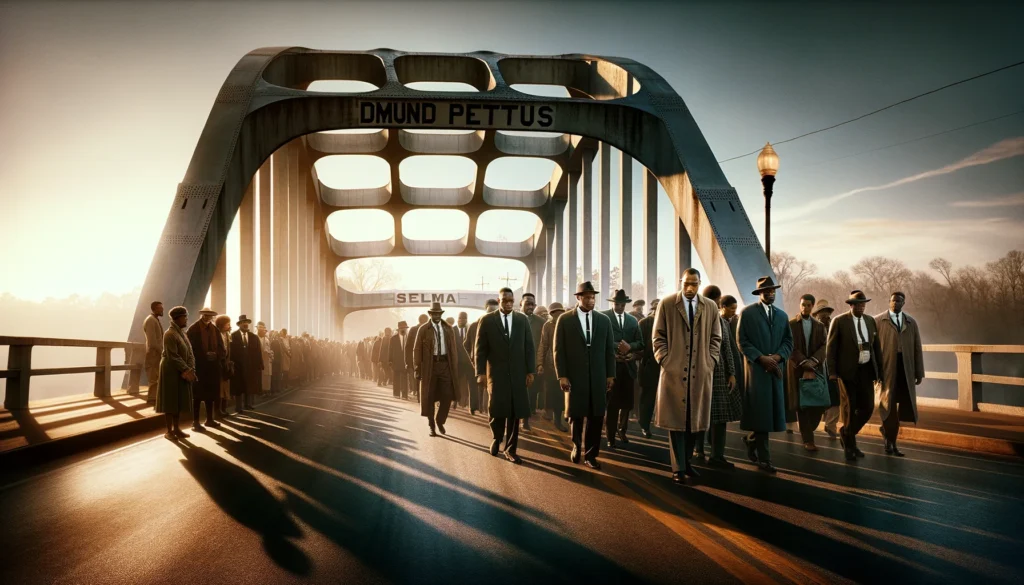
Reviving Democracy: The John R. Lewis Voting Rights Advancement Act Fights Voter Suppression.
By Darius Spearman (africanelements)
Support African Elements at patreon.com/africanelements and hear recent news in a single playlist, plus get early access to ad-free video content.
Strengthening Democracy Through the John R. Lewis Voting Rights Advancement Act
In a significant move to safeguard the cornerstone of democracy, Senate Democrats have once again put forth the John R. Lewis Voting Rights Advancement Act. This signals a profound commitment to restoring and fortifying the Voting Rights Act (VRA). As we approach the 59th anniversary of the harrowing events of “Bloody Sunday,” the urgency to protect fundamental voting rights has never been more pronounced. Therefore, the need for legislative action is clear. This legislative effort aims to address the erosion of voter protections. Specifically, it responds to the Supreme Court’s 2013 decision in Shelby County v. Holder, which significantly weakened the VRA’s enforcement mechanisms.
The bill introduces a modernized formula for preclearance and addresses recent barriers to fair litigation under Section 2 of the VRA. Thus, the bill stands as a beacon of hope. It seeks to reverse the tide of restrictive voting practices that disproportionately affect communities of color.
Senate Democrats Champion Voting Rights Restoration
The reintroduction of the John R. Lewis Voting Rights Advancement Act comes just before the 59th anniversary of “Bloody Sunday.” The act aims to restore and strengthen the Voting Rights Act (VRA) (Judiciary Senate). Specifically, it seeks to update the formula for determining which states need preclearance before changing voting laws. This is in response to the Supreme Court’s 2013 Shelby County v. Holder decision (ACLU).
Moreover, the bill intends to make it easier to challenge discriminatory practices. It does so by addressing recent Supreme Court decisions that added hurdles for lawsuits under Section 2 of the VRA (Judiciary Senate). The original VRA of 1965 was a landmark law. However, its provisions have been weakened over time by the Supreme Court (ACLU).
From “Bloody Sunday” to Today: The Evolution of Voting Rights
“Bloody Sunday” refers to a pivotal event on March 7, 1965. On that day, a peaceful march for African American voting rights turned violent on the Edmund Pettus Bridge in Selma, Alabama. State and local police brutally attacked the marchers with billy clubs, whips, and tear gas. John Lewis was among the civil rights leaders who led the March. At the time, Lewis was a member of the Student Nonviolent Coordinating Committee (SNCC). The March was a response to the systemic suppression of Black votes and the murder of activist Jimmie Lee Jackson.
The violence of Bloody Sunday was broadcast on national television, shocking many Americans and galvanizing support for the civil rights movement. This event, along with subsequent marches, played a crucial role in the passage of the Voting Rights Act of 1965, a landmark federal achievement of the civil rights movement (NMAAHC, EJI).
The John R. Lewis Voting Rights Advancement Act is directly connected to the legacy of Bloody Sunday and the broader struggle for voting rights. Named after the late Congressman and civil rights icon Lewis was among those beaten on Bloody Sunday. The act seeks to restore and modernize the 1965 Voting Rights Act. It addresses the challenges that have emerged following the Supreme Court’s decisions that weakened the act’s protections.
Supreme Court Decisions and the Battle for Democracy
Chief among those decisions was the Shelby County v. Holder decision in 2013. The legislation aims to ensure that all voters have a voice in selecting their leaders. Specifically, it focuses on those in communities of color, enabling their free and fair exercise of the right to vote. By requiring preclearance on a nationwide scale for practices that disproportionately affect communities of color, the John R. Lewis Voting Rights Advancement Act represents a continuation of the fight for equal voting rights for all Americans. The Act honors the sacrifices Lewis and others made during the civil rights movement (NETWORK).
The Voting Rights Act of 1965 (VRA) was a landmark piece of federal legislation in the United States. The aimed to eliminate racial discrimination in voting. It was successful for nearly half a century in ensuring minority voting rights. However, the VRA’s effectiveness was significantly weakened by the Supreme Court’s Shelby County v. Holder decision in 2013. In this decision, the Court invalidated a key provision of the VRA, the preclearance requirement. This requirement mandated that certain states and localities with a history of discrimination obtain federal approval before changing voting rules (Brennan Center for Justice).
The removal of the preclearance provision led to a surge in restrictive voting laws and practices across the country. Notably, states like Georgia, Florida, and Texas have erected significant barriers for people of color. These barriers have made it increasingly difficult for them to exercise their voting rights (Lawyers’ Committee for Civil Rights Under Law).
Supreme Court Decisions and the Battle for Democracy
In response to this weakening of the VRA, the John R. Lewis Voting Rights Advancement Act seeks to restore the protections that were stripped away. It proposes a new formula for determining which jurisdictions require preclearance and aims to strengthen legal protections against discriminatory voting policies. The act also responds to the 2021 Brnovich v. Democratic National Committee decision, which made it more difficult to challenge discriminatory laws under Section 2 of the VRA (Brennan Center for Justice).
The John R. Lewis Voting Rights Advancement Act represents an effort to honor the legacy of Bloody Sunday and the civil rights movement. Consequently, it ensures voting rights protections for all Americans, particularly those who have historically faced discrimination at the polls.
Ensuring Fair Elections: The Modernized Preclearance Formula
The John R. Lewis Voting Rights Advancement Act contains several key provisions designed to protect and enhance voting rights:
- Modernizing the Preclearance Formula: It updates the formula for determining which states and localities require federal approval before changing voting laws. This is in response to the Supreme Court’s decision in Shelby County v. Holder, which invalidated the previous formula (Brennan Center for Justice).
- Public Announcement of Voting Changes: The act requires officials to publicly announce all changes to voting procedures. This ensures that last-minute changes do not adversely affect voters (Human Rights Campaign).
- Federal Observers: It expands the government’s authority to send federal observers to any jurisdiction where there may be a substantial risk of voting rights violations (Human Rights Campaign).
- Restoring Section 2 Protections: The act aims to restore Section 2 of the VRA by eliminating the heightened standard required to challenge discriminatory practices. This is in response to the Supreme Court’s decision in Brnovich v. Democratic National Committee (Wikipedia).
- Protecting Vulnerable Voters: The legislation addresses the specific challenges faced by minority voters, including transgender individuals who may not have ID that reflects their true gender identity (Human Rights Campaign).
- Stopping Discriminatory Laws: By restoring the VRA’s authority, the act aims to prevent restrictive and discriminatory voting laws from taking effect in states and localities with a recent history of discrimination (Office of Rep. Terri Sewell).
The Legacy of John Lewis: Continuing the Fight for Equality
These provisions collectively seek to counteract the wave of restrictive voting laws and practices. This wave has gained momentum particularly since the Supreme Court’s 2013 decision. Additionally, the act seeks to honor the legacy of John Lewis.
The reintroduction of this act is a direct response to ongoing efforts to restrict voting access. These efforts disproportionately affect voters of color, especially Black voters (Brennan Center). Previously, the bill passed the House but was stalled in the Senate by Republicans. Now, Senate Democrats, led by Dick Durbin, Chuck Schumer, and Raphael Warnock, are pushing to pass this critical legislation (Judiciary Senate).
Conclusion: A Call to Action for Voting Rights Protection
The reintroduction of the John R. Lewis Voting Rights Advancement Act represents more than just a legislative proposal. It is a call to action for all who believe in the principles of democracy and equality. As the act makes its way through the legislative process, it carries with it the legacy of those who fought and sacrificed for the right to vote—especially in the face of systemic barriers and violence. This moment demands a collective effort to uphold and advance the gains of the civil rights movement.
By supporting the passage of this act, lawmakers ensure that the fight against voter suppression and discrimination continues. Simultaneously, they honor the memory of John Lewis and the countless others who stood up for justice. The passage of the John R. Lewis Voting Rights Advancement Act is not just a matter of policy. It is also a profound act of recommitment to the most basic tenets of our democracy.
About the author:
Darius Spearman is a professor of Black Studies at San Diego City College, where he has been pursuing his love of teaching since 2007. He is the author of several books, including Between The Color Lines: A History of African Americans on the California Frontier Through 1890. You can visit Darius online at africanelements.org.
